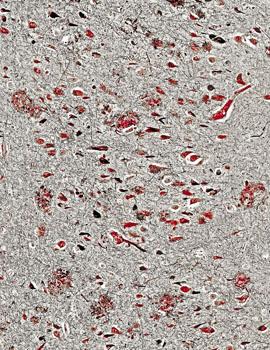Multiple pathways progressing to Alzheimer's disease

This is a micrograph of amyloid plaques and neurofibrillary tangles in human brain. Credit: Thomas Deerinck/National Center for Microscopy and Imaging Research at UC San Diego
The amyloid cascade hypothesis of Alzheimer's disease (AD) posits that sticky aggregations or plaques of amyloid-beta peptides accumulate over time in the brain, triggering a series of events that ultimately result in the full-blown neurodegenerative disorder. The hypothesis has been a major driver of AD research for more than 20 years.
However, in a new study published this week online in the Journal of Alzheimer's Disease, researchers at University of California, San Diego School of Medicine and Veterans Affairs San Diego Healthcare System suggest the picture is not so clear-cut, reporting that early indicators or biomarkers of AD development are not fixed in a specific sequence.
“Our current ability to identify early stages of AD is limited by the focus on amyloid accumulation and the expectation that biomarkers follow the same timeline for all individuals,” said Emily C. Edmonds, PhD, a senior postdoctoral fellow in the Department of Psychiatry and first author of the study.
But, Edmonds said, “AD is complex in the sense that there may be different neurobiological pathways leading to expression of the disease. Our findings suggest that the number of abnormal biomarkers and cognitive markers an individual possesses, without regard to the temporal sequence, is most predictive of future decline.”
“Preclinical AD” is a very early stage of AD prior to the appearance of diagnosable symptoms. Current National Institute of Aging-Alzheimer's Association (NIA-AA) criteria for preclinical AD describe a disease progression that begins with accumulation of amyloid-beta, leading to neurodegeneration, cognitive decline and, eventually, diagnosable AD.
In their study, researchers classified 570 cognitively normal participants in the Alzheimer's Disease Neuroimaging Initiative according to NIA-AA criteria, and then separately examined the participants based upon the presence and number of abnormal biological and cognitive markers associated with preclinical AD. They found that neurodegeneration alone was 2.5 times more common than amyloid accumulation alone at baseline measurements.
They then examined only those participants who progressed to a diagnosis of mild cognitive impairment, which is an at-risk cognitive state of AD. They found that it was most common to show neurodegeneration as the first sign of early AD, and equally common to show amyloid accumulation or subtle cognitive decline as the first sign.
Edmonds said that the findings underscore the need to improve identification of persons at risk for AD through the use of multiple, diverse assessment tools. This includes sensitive learning and memory tests capable of reliably identifying cognitive changes at the earliest stages.
“At present, it is much more common for assessment of cognition to be based on insensitive screening measures or reports of cognitive problems by patients or their family members,” said Edmonds. “These blunt screening tools can be very unreliable, which might explain why cognitive decline has traditionally been viewed as occurring later in the disease process. The integration of sensitive neuropsychological measures with assessment of biomarkers of AD can enhance our ability to more accurately identify individuals who are at risk for future progression to AD.”
###
Co-authors include Lisa Delano-Wood, Douglas R. Galasko, and Mark W. Bondi, UCSD and Veterans Affairs San Diego Healthcare System; and David P. Salmon, UCSD.
Funding for this research came, in part, National Institutes of Health grants R01 AG012674, K24 AG026431 and P50 AG05131.
Media Contact
All latest news from the category: Health and Medicine
This subject area encompasses research and studies in the field of human medicine.
Among the wide-ranging list of topics covered here are anesthesiology, anatomy, surgery, human genetics, hygiene and environmental medicine, internal medicine, neurology, pharmacology, physiology, urology and dental medicine.
Newest articles

A new puzzle piece for string theory research
Dr. Ksenia Fedosova from the Cluster of Excellence Mathematics Münster, along with an international research team, has proven a conjecture in string theory that physicists had proposed regarding certain equations….

Climate change can cause stress in herring larvae
The occurrence of multiple stressors undermines the acclimatisation strategies of juvenile herring: If larvae are exposed to several stress factors at the same time, their ability to respond to these…

Making high-yielding rice affordable and sustainable
Plant biologists show how two genes work together to trigger embryo formation in rice. Rice is a staple food crop for more than half the world’s population, but most farmers…



